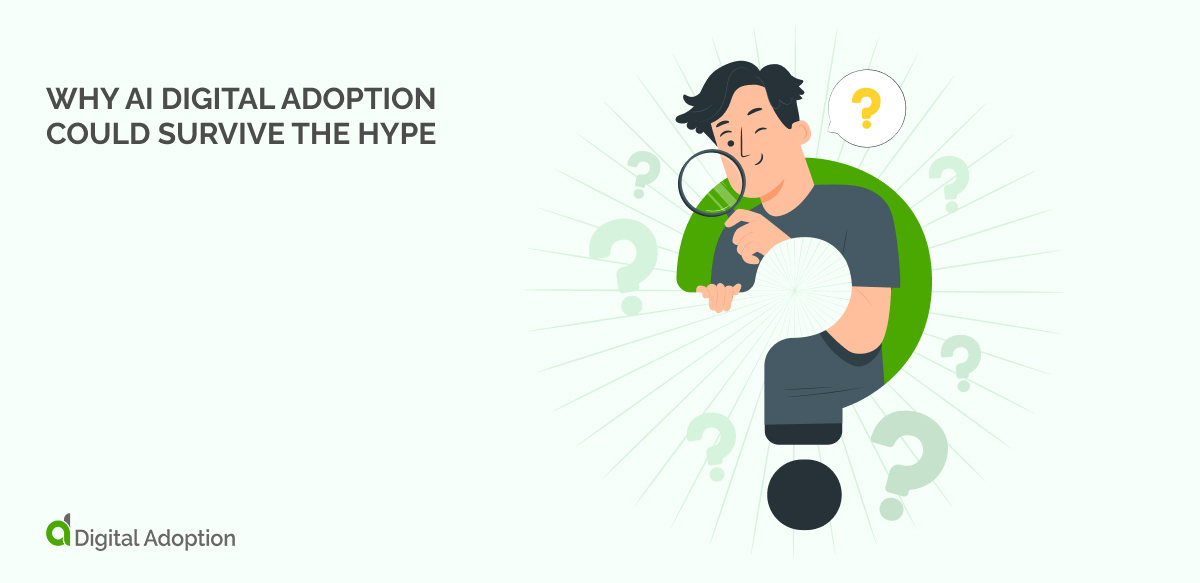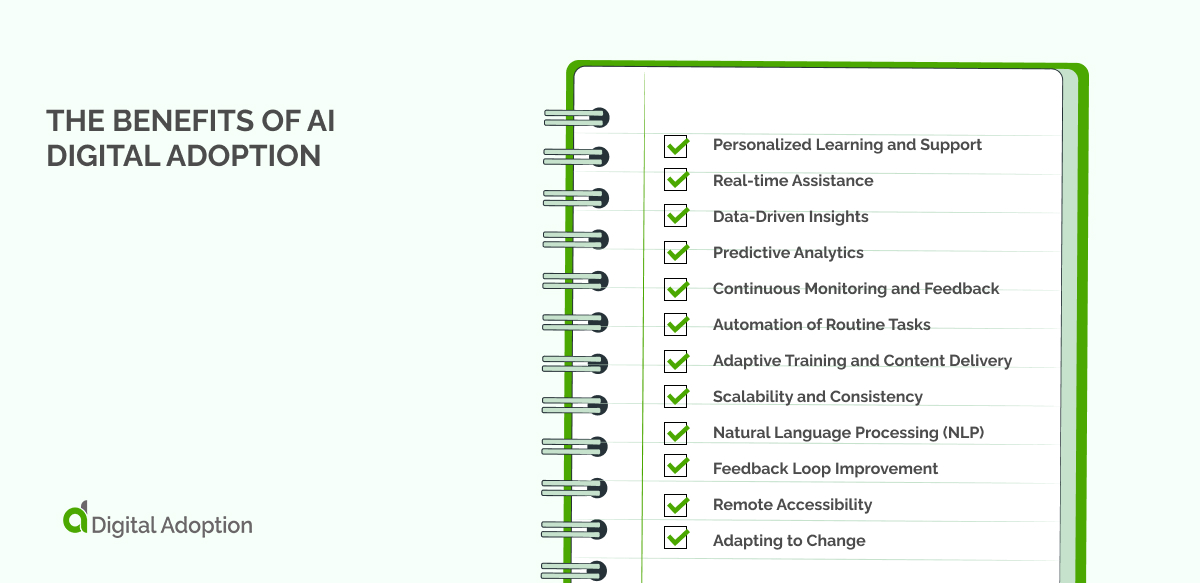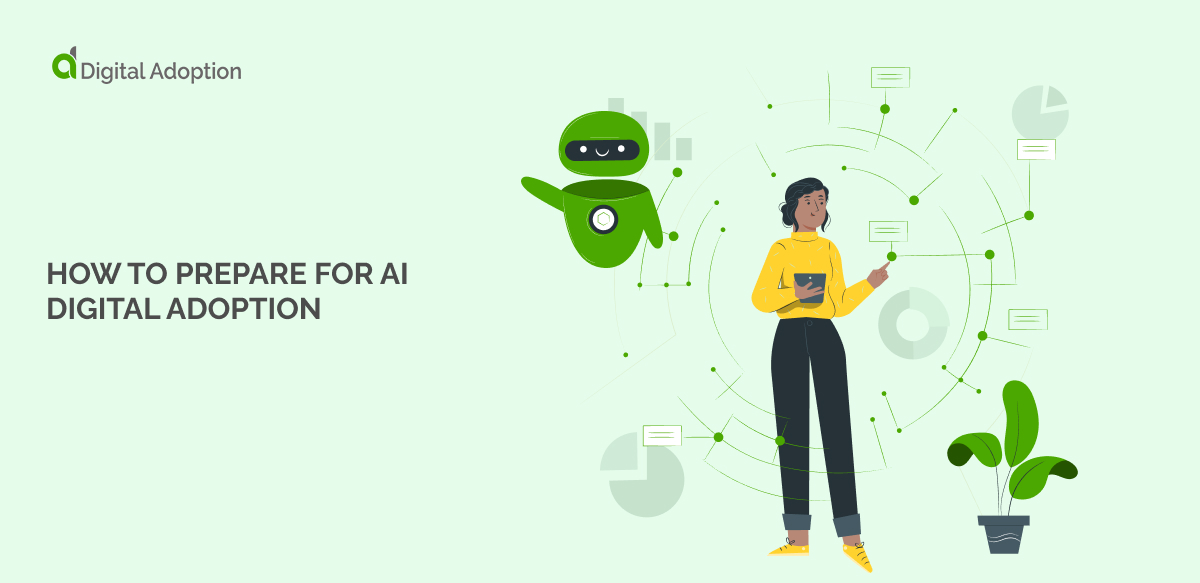“AI digital adoption” is the implementation of artificial intelligence for any kind of digital adoption project.
The software market does not have a full offering of AI digital adoption solutions because AI is an emerging technology for digital adoption (as it is in all industries).
Nonetheless, AI in digital adoption will likely help businesses monitor shadow AI, provide training support for AI applications, and operate with AI-driven engines.
AI could support some of the most important aims of digital adoption planning. These aims include improving efficiency by automating repetitive processes, improving customer experience, and facilitating better collaboration.
As these goals are so important for any data-driven business, it makes sense to explore AI as a key part of digital adoption. This article will introduce the topic by:
- Giving an overview of what AI means for digital adoption;
- Explaining why AI in digital adoption will be a success story;
- Introducing the major benefits of AI for digital adoption.
If you’re wondering whether AI could make a difference to your digital transformation plans, read on to find out how.
What is AI in digital adoption?
AI digital adoption is using, supervising, and managing Artificial Intelligence (AI) in a Digital Adoption program. AI is especially important for Digital Adoption platforms, which this article will pay special attention to.
In 2023, AI already has an important place in digital adoption. Currently, “AI” has become almost synonymous with “generative AI” – ChatGPT, Bard, and all the third-party apps they power. However, different forms of AI have been used in digital adoption for many years. For example, the Digital Adoption Platform WalkMe has been integrating AI-based predictive analytics since 2018.
The use of generative AI in digital adoption is still an emerging technology. We don’t even have a standard set of AI-based products – yet.
However, software companies like WalkMe, Workday, and Whatfix are all starting to introduce introducing AI services.
We can expect to see generative AI in digital adoption platforms to include:
- Detecting, monitoring, and evaluating shadow AI practices in a company. At this stage, many employees use AI in an unauthorized capacity. In other words, IT leadership cannot easily see how AI is being implemented, and the results are highly risky. Digital Adoption platforms will soon be able to monitor these systems closely.
- Adopting AI processes effectively (also known as AI adoption) Like any form of digital transformation, technology must be well-implemented through training, workflow support, and contextual help systems.
- Using generative AI to improve general digital adoption. AI can enhance automation practices and undertake basic analysis of user activity. The tech stacks of most large companies are huge – producing oodles of data every day.
- Generative-AI-based chatbots and search tools to enhance the customer experience of end products. The implications of AI for customer service cover all industries. In digital adoption, a chatbot can direct users to the ideal answers to their questions.
Today, there are very few off-the-shelf AI tools. But in the coming months and years, they will likely become a “must-have” for digital transformation projects.
Why AI digital adoption could survive the hype

AI is still going through a wild journey of hype. We see astonishing claims, high business valuations, and the potential for billions of dollars of global growth. Although we don’t think AI in digital adoption will change the world, it is clearly here to stay.
Of course, some observers promise that AI will unlock the gates of digital transformation. In August 2023, for example, Dr TJ Jiang of AvePoint claimed, “The best way to accelerate digital transformation is to implement low-code and no-code applications and generative AI right away.” However, for a DAP platform, these must be carefully considered.
On the other hand, an increasing number of people are raising questions about AI’s future value. Gary Marcus has pointed out that ChatGPT’s unreliability for basic information is already causing problems in the legal and research communities. “The whole generative AI economy… could see a massive, gut-wrenching correction” in the near future.
The “AI bubble” could burst sometime soon. However, we believe AI has a clear future value for digital adoption. Even if the armies of prompt engineers and over-valued AI startups have no future – AI can help IT leaders reach digital maturity more effectively.
Even if the AI industry explodes:
- IT leaders will need to have a way to track shadow AI use.
- DAPs still need to use every method available to improve customer experiences.
- Users will still need help to use AI solutions effectively.
Regarding digital adoption in AI, we are not looking for a stand-in for “artificial general intelligence.” AI can serve the goals of business users without approaching the risks that many other sectors will encounter.
The benefits of AI digital adoption

Before we round up, let’s take a moment to think about the potential benefits of digital adoption.
The fundamental benefits are very similar to other specific business areas like insurance, sales, and education.
But, AI can play a specific (and crucial) role in a digital adoption program for several reasons. Let’s take a quick look.
- Personalized Learning and Support: AI can provide personalized learning paths and support to users based on their skill levels, preferences, and learning styles. This tailored approach can help users better understand and adapt to new digital tools.
- Real-time Assistance: AI-powered chatbots or virtual assistants can offer real-time assistance to users, instantly addressing their queries and concerns. This reduces frustration and improves the overall user experience during the adoption process.
- Data-Driven Insights: AI can analyze user interactions and behaviors to provide insights into their challenges and progress. This data-driven approach enables program managers to make informed decisions and adjustments to improve the adoption process.
- Predictive Analytics: AI can predict potential roadblocks or challenges users might face during adoption. Program managers can proactively provide solutions or resources to overcome these issues by anticipating them.
- Continuous Monitoring and Feedback: AI can continuously monitor user engagement and performance with digital tools. This allows program managers to identify areas where users might be struggling and offer timely guidance or training to bridge the gaps.
- Automation of Routine Tasks: AI can automate repetitive and time-consuming tasks, freeing human resources to focus on more strategic aspects of the adoption program. This can include user onboarding, tracking progress, and sending reminders.
- Adaptive Training and Content Delivery: AI can adapt training materials and content delivery based on user feedback and performance. This ensures users receive the most relevant and effective resources throughout their learning journey.
- Scalability and Consistency: AI-driven solutions can be scaled up easily to accommodate a large number of users without compromising the quality of support. This ensures consistent and standardized assistance across the program.
- Natural Language Processing (NLP): AI-powered NLP technology can help users interact with digital tools using natural language, making learning more intuitive and user-friendly.
- Feedback Loop Improvement: AI can gather user feedback about their experiences and challenges, enabling continuous improvement of the adoption program.
- Remote Accessibility: In remote work scenarios, AI can provide remote users with immediate access to guidance and support, regardless of their location or time zone.
- Adapting to Change: AI can help organizations adapt to changes in digital tools and technologies by providing agile and dynamic support to users as new tools are introduced.
Incorporating AI into a digital adoption program can enhance the overall experience for users, increase the speed and effectiveness of learning, and ultimately lead to higher rates of successful adoption of new digital tools and technologies.
AI capabilities will support digital adoption
Working with AI is still new. And if anyone claims to be an expert in the field, you should carefully examine their qualifications. Very few people understand how AI can impact business growth.
Nonetheless, it’s gradually becoming clear that AI technology will be a part of the business models of tomorrow. McKinsey’s research shows successful companies invested as much as 10% of their IT budgets in AI in 2019-2020.
As we’ve seen in this article, AI could greatly impact how every digital adoption platform works: for AI adoption, monitoring shadow AI, and supporting enterprises’ training programs.













